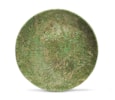Large Mosaic Glass Dish
Large Mosaic Glass Dish
Large Mosaic Glass Dish
1st Century B.C.-1st Century A.D., Roman
Glass
Diam: 20 cm, H: 5 cm
Sold
A shallow glass dish with a composite mosaic pattern formed from polygonal sections of yellow and green canes, set into a translucent green background.
Mosaic glass bowls, dishes, and cups from the late first century B.C. were among the first Roman antiquities to be discovered across Italy. The manufacturing process for these glasswares was developed from that used by Hellenistic craftsmen, and the objects therefore maintain certain stylistic similarities. Creating mosaic glass was highly laborious and time consuming. The separate multicoloured glass canes had to be created and shaped, and then cut either into small, circular pieces or long strips. The pieces were positioned to arrange a flat circle, heated until they fused, and then draped over a mould to produce the final shape. The objects would then need to be polished in order to smooth any imperfections. Mosaic glass was incredibly popular throughout the Roman Empire.
Previously in the Private Collection of Ernst (1903-1990) and Marthe Kofler-Truniger (1918-1999), Lucerne, from at least 1985.
Sold at: Ancient Glass Formerly the Kofler-Truniger Collection, Christie’s, London, 5th-6th March 1985, Lot 181.
With Aaron Gallery, London, acquired from the above sale.
With David Aaron Ancient Arts, London, 2005-2012.
Private Collection of Sheikh Saud bin Mohammed Al Thani (1966-2014), London, acquired from the above on 13 February 2012.
Thence by descent, London.
ALR: S00261298, with IADAA Certificate, this item has been checked against the Interpol database.










 Enquire
Enquire




